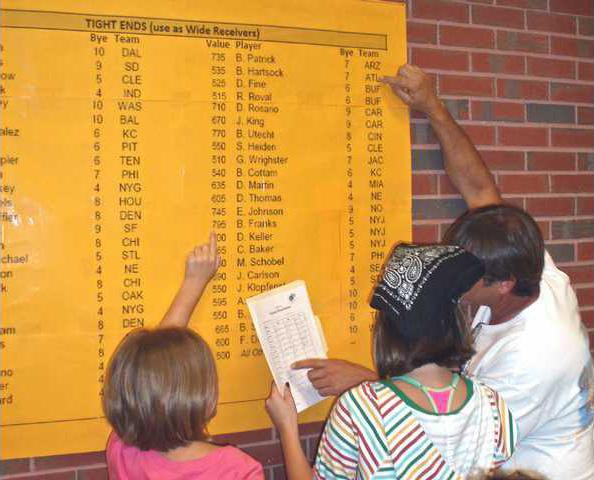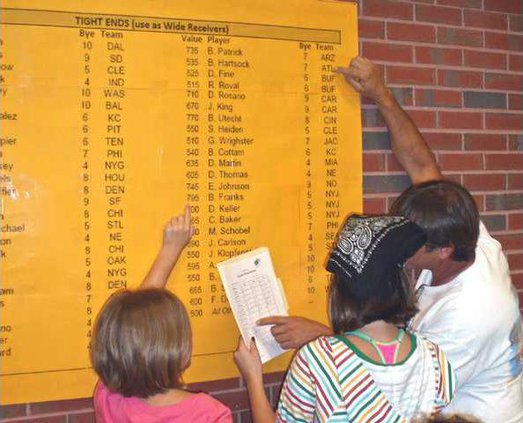Football season is in full swing and while most fans sweat over statistics in their bleachers or recliners, Southeast Bulloch Middle School students are crunching stats in the classroom.
The school recently held its Second Annual Fantasy Football Extravaganza to kick off a 10-week math project that gives sixth grade students real life connections between math and football.
More than 300 parents and students enjoyed the fun-filled evening huddled around pizza and pick-sheets while putting together their professional Fantasy Football team.
“It's a special experience to watch parents bond with their children and learn math at the same time,” said Shannon Robertson, the school's media specialist.
Math teachers Dr. Patia Rountree and Tracey Simons began the program in 2008 after hearing Dan Flockhart, author of “Fantasy Sports and Mathematics,” at the 2008 National Council of Teachers of Mathematics Conference in Salt Lake City.
“We thought the program had a lot to offer, and we felt that our students would enjoy combining math and football,” said Rountree, a 2009 recipient of the Presidential Award of Excellence for Mathematics.
Flockhart, a former middle school math teacher, wrote the curriculum to improve students' ability to solve problems involving fractions, decimals and percentages. U.S. Department of Education research confirms that 80 percent of eighth grade students have difficulty solving problems with these type operations. The program, which has drawn attention from leading educational journals, ESPN and the Associated Press, is being used in middle and high schools throughout the nation. Curriculum also exists for baseball, basketball and soccer.
Rountree and Simons use the program with their sixth grade classes to specifically reinforce math operations with fractions and formulas. The project culminates with an awards ceremony in November.
SEB Middle math students and their parents selected their teams, and they compete against other classmates' teams with the goal being to accumulate the greatest number of points each game.
Students track their teams by reading statistical game summaries that are found online, on television or in newspapers. Each team receives points based on game statistics: touchdowns, quarterback sacks, first downs and other plays earn points. For students, Flockhart's version represents the point structure in fractions and worksheets can be integrated throughout the game to reinforce certain math concepts.
Fantasy Football is just one way SEBMS math teachers use their creativity to teach math. Mary Jones, the school's eighth grade mathematics teacher, and a Georgia Master Teacher designee, recently designed and implemented a Cartesian Coordinate Plane, and she is writing a grant to fund installing a second one. The current gridlines are now permanent floor tiles in the school's hallway commons, and they create a virtual classroom to apply geometry and algebra skills. Cartesian coordinates were developed in the 17th century by René Decartes and revolutionized the link between geometry and algebra.
Each year students also participate in Pi Day that is celebrated annually on March 14, by math teachers around the world and used to teach the theory of Pi [( ) the symbol for the ratio of the circumference of a circle to its diameter; Pi = 3.1415926535....]. In past years, SEBMS faculty and students got involved by designing and wearing t-shirts that showed different representations of Pi.
Later in the year, students will construct The Sieve of Eratosthenes during a math project night. The Sieve of Eratosthenes is a simple, ancient algorithm for finding all prime numbers up to a specified integer, and it was developed around 200 B.C. by the Greek mathematician Eratosthenes of Cyrene.
Rountree, Simons and Jones are successful transforming a school hallway into a football field, and the world a classroom for their students. All their efforts are aimed at connecting math children learn in the classroom with math in the real world.
The school recently held its Second Annual Fantasy Football Extravaganza to kick off a 10-week math project that gives sixth grade students real life connections between math and football.
More than 300 parents and students enjoyed the fun-filled evening huddled around pizza and pick-sheets while putting together their professional Fantasy Football team.
“It's a special experience to watch parents bond with their children and learn math at the same time,” said Shannon Robertson, the school's media specialist.
Math teachers Dr. Patia Rountree and Tracey Simons began the program in 2008 after hearing Dan Flockhart, author of “Fantasy Sports and Mathematics,” at the 2008 National Council of Teachers of Mathematics Conference in Salt Lake City.
“We thought the program had a lot to offer, and we felt that our students would enjoy combining math and football,” said Rountree, a 2009 recipient of the Presidential Award of Excellence for Mathematics.
Flockhart, a former middle school math teacher, wrote the curriculum to improve students' ability to solve problems involving fractions, decimals and percentages. U.S. Department of Education research confirms that 80 percent of eighth grade students have difficulty solving problems with these type operations. The program, which has drawn attention from leading educational journals, ESPN and the Associated Press, is being used in middle and high schools throughout the nation. Curriculum also exists for baseball, basketball and soccer.
Rountree and Simons use the program with their sixth grade classes to specifically reinforce math operations with fractions and formulas. The project culminates with an awards ceremony in November.
SEB Middle math students and their parents selected their teams, and they compete against other classmates' teams with the goal being to accumulate the greatest number of points each game.
Students track their teams by reading statistical game summaries that are found online, on television or in newspapers. Each team receives points based on game statistics: touchdowns, quarterback sacks, first downs and other plays earn points. For students, Flockhart's version represents the point structure in fractions and worksheets can be integrated throughout the game to reinforce certain math concepts.
Fantasy Football is just one way SEBMS math teachers use their creativity to teach math. Mary Jones, the school's eighth grade mathematics teacher, and a Georgia Master Teacher designee, recently designed and implemented a Cartesian Coordinate Plane, and she is writing a grant to fund installing a second one. The current gridlines are now permanent floor tiles in the school's hallway commons, and they create a virtual classroom to apply geometry and algebra skills. Cartesian coordinates were developed in the 17th century by René Decartes and revolutionized the link between geometry and algebra.
Each year students also participate in Pi Day that is celebrated annually on March 14, by math teachers around the world and used to teach the theory of Pi [( ) the symbol for the ratio of the circumference of a circle to its diameter; Pi = 3.1415926535....]. In past years, SEBMS faculty and students got involved by designing and wearing t-shirts that showed different representations of Pi.
Later in the year, students will construct The Sieve of Eratosthenes during a math project night. The Sieve of Eratosthenes is a simple, ancient algorithm for finding all prime numbers up to a specified integer, and it was developed around 200 B.C. by the Greek mathematician Eratosthenes of Cyrene.
Rountree, Simons and Jones are successful transforming a school hallway into a football field, and the world a classroom for their students. All their efforts are aimed at connecting math children learn in the classroom with math in the real world.

